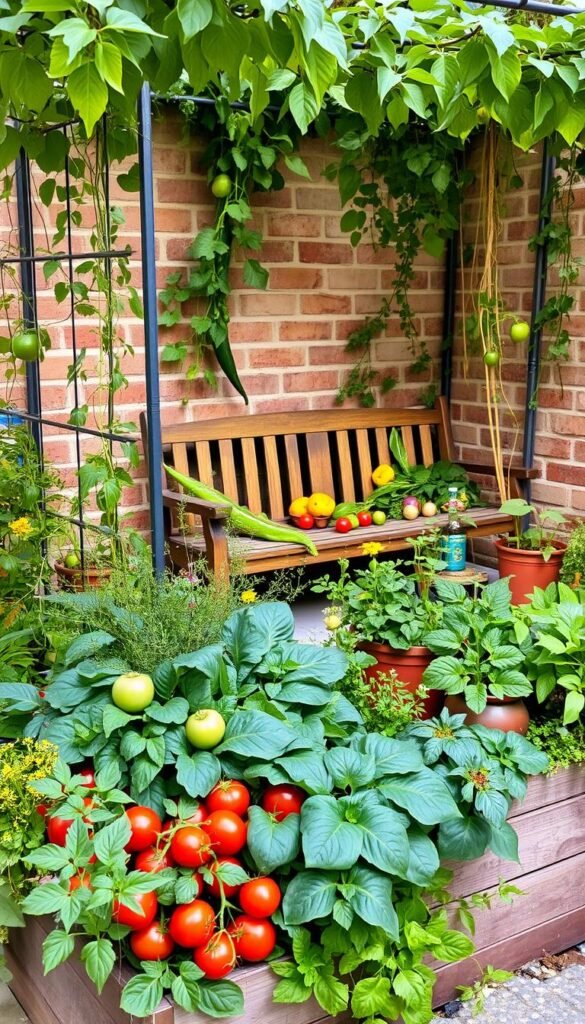Ever wondered how to grow fresh food without acres of land? Your patio, balcony, or compact yard holds untapped potential for delicious harvests. With smart design, even tight areas can burst with tomatoes, herbs, and leafy greens—no farm required.
Real gardeners prove it’s possible. Take Jessica from Portland, who grows 50 lbs of veggies yearly on her 8×10 balcony. Or Mark in Chicago, whose fire escape hosts three varieties of peppers. Their secrets? Creative layouts and space-smart techniques that work harder than traditional rows.
Small spaces have hidden perks. You’ll spot pests faster, water precisely, and control sunlight better. Plus, containers let you rearrange plants like puzzle pieces as seasons change. Think vertical: trellises for beans, hanging baskets for strawberries, wall planters for herbs.
This guide shows how to match your unique setup with proven strategies. Discover which crops thrive in pots, how to pair plants for maximum yield, and why intensive planting beats old-school row spacing. Ready to turn that sunny corner into your personal produce aisle?
Understanding Your Patio Vegetable Garden Vision
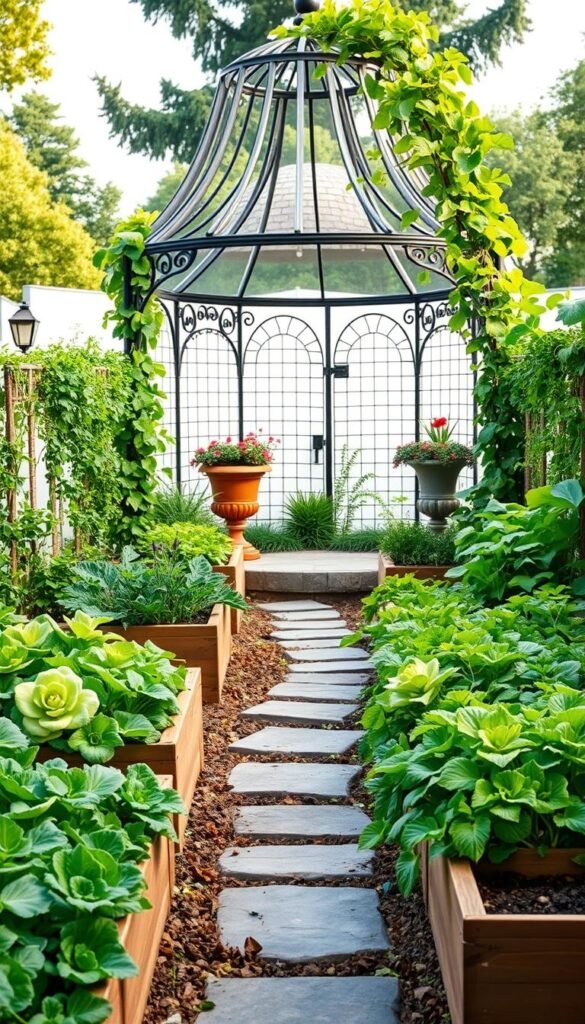
What makes your edible oasis truly yours? It starts with seeing possibilities where others see limits. Your compact growing zone becomes a canvas where practicality meets personal style.
Mapping Your Unique Conditions
Grab a tape measure and notebook. Jot down:
- Sun patterns (morning vs afternoon light)
- Wind corridors near walls/railings
- Water source locations
Urban grower Emma Tran reshaped her 6′ balcony by tracking shadows for 3 days. “My lettuce moved three times before finding its happy spot,” she laughs.
Cultivating Your Personal Approach
Ask: “What flavors make my meals sing?” A pizza lover might prioritize basil and cherry tomatoes. A smoothie enthusiast could focus on kale and strawberries. See how preferences shape plans:
| Space Size | Top Picks | Layout Tip |
|---|---|---|
| Under 25 sq ft | Herbs, microgreens | Stack vertical planters |
| 25-50 sq ft | Peppers, bush beans | Use corner trellises |
| 50+ sq ft | Zucchini, cucumbers | Rotate crops seasonally |
Remember—your setup will evolve. Start simple, then add complexity as you learn. As Portland designer Leo Marquez advises: “Grow what you’ll eat, then eat what you grow.”
Essential Design Principles for a Small Space Garden
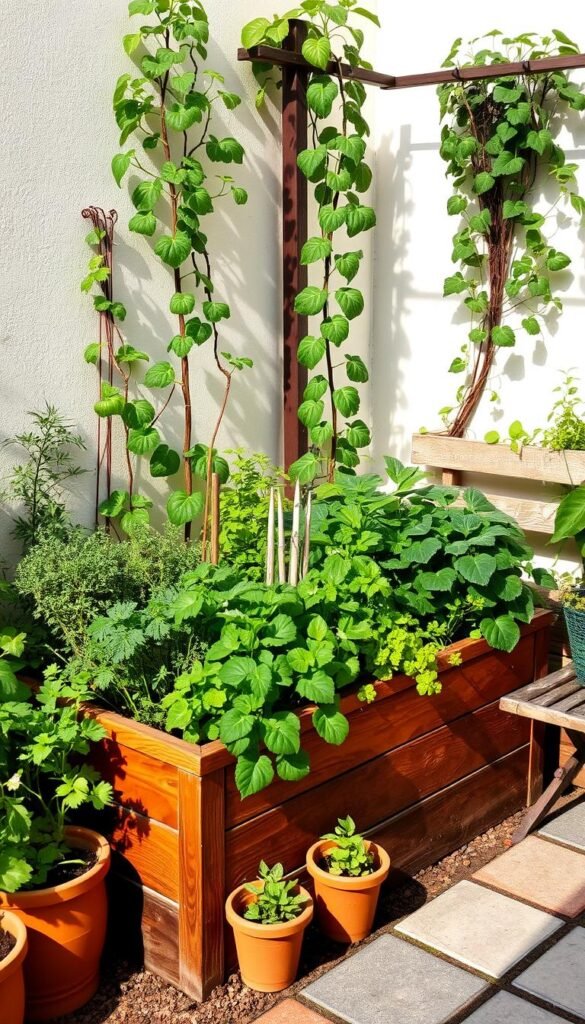
Limited square footage demands clever strategies to grow thriving plants. Focus on three core elements: light exposure, earth quality, and smart arrangement. These factors determine whether your green investments flourish or struggle.
Assessing Sunlight, Soil, and Space
Track sunlight patterns for 3 days using a phone app or notebook. Most edibles need 6-8 hours of direct light. No full sun? Try leafy greens or herbs like mint that tolerate shade.
Test your soil’s personality. Squeeze a handful—if it holds shape but crumbles when poked, you’ve got good drainage. For containers, use potting mix with perlite. Raised beds thrive with 60% topsoil, 30% compost, and 10% sand.
| Growing Method | Soil Mix Formula | Key Additives |
|---|---|---|
| Containers | 70% potting soil | Slow-release fertilizer |
| Raised Beds | 50% garden soil | Worm castings |
| Window Boxes | 80% peat-free mix | Water crystals |
Planning a Functional Layout
Sketch your area using graph paper. Place tall crops (tomatoes, pole beans) on the north side to prevent shading. Leave 18″ pathways between beds—you’ll thank yourself during harvest.
Think upward: attach gutter planters to railings for strawberries. Use tiered stands to grow three herb varieties in one square foot. Rotate pots seasonally to match light changes.
| Space Type | Vertical Solution | Plant Picks |
|---|---|---|
| Narrow balcony | Wall-mounted pockets | Thyme, lettuce |
| Paved patio | Ladder shelf | Peppers, basil |
| Fire escape | Hanging baskets | Cherry tomatoes |
Incorporating Raised Beds and Vertical Gardens
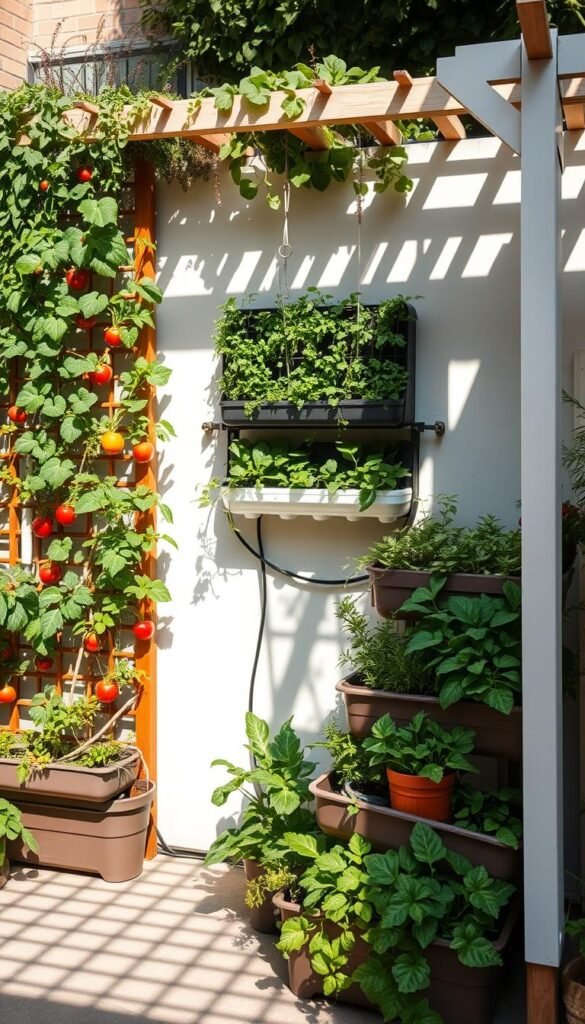
Transform cramped areas into lush edible zones by building upward and outward. Strategic elevation lets you bypass poor ground conditions while multiplying planting real estate. Let’s explore how these space-smart systems work.
Advantages of Raised Beds
Elevated raised beds solve multiple challenges at once. Their benefits include:
- Custom soil blends for healthier plants
- Warmer roots for earlier spring planting
- Reduced back strain with waist-high designs
Choose materials wisely. Cedar resists rot, while galvanized steel offers modern flair. One Chicago gardener built tiered beds from reclaimed pallets, growing 15 varieties of greens in 20 square feet.
Vertical Gardening Techniques and Trellis Ideas
Turn blank walls into edible tapestries with these vertical garden strategies:
| Structure | Best Plants | Space Saved |
|---|---|---|
| Bean teepees | Pole beans, peas | 65% ground area |
| Wall grids | Cucumbers, melons | 80% footprint |
| Hanging pockets | Strawberries, herbs | 100% floor space |
Combine raised beds with climbing systems for layered productivity. Try planting basil below tomato towers—the herbs deter pests while enjoying dappled shade. Your garden becomes a 3D ecosystem where every inch works overtime.
Embracing Companion Planting for Healthier Crops
Nature thrives on teamwork—your edible plants can too. Companion planting turns your growing area into a vibrant community where plants support each other’s growth. This ancient practice reduces pests naturally and boosts yields without chemicals.
Choosing Beneficial Plant Combinations
Smart pairings create living pest control systems. Try these proven partnerships:
| Plant Pair | Benefits | Best For |
|---|---|---|
| Tomatoes + Basil | Repels flies/mosquitoes | Container gardens |
| Carrots + Chives | Deters carrot flies | Raised beds |
| Lettuce + Marigolds | Blocks nematodes | Window boxes |
| Corn + Squash | Weed suppression | Vertical systems |
Tall crops like corn shield tender seedlings from wind. Sprawling squash vines act as living mulch, keeping soil moist. “My peppers stopped getting sunburned when I planted sunflowers behind them,” notes urban gardener Maria Rodriguez from Phoenix.
Flowers aren’t just pretty—they’re pest police. Marigolds release soil chemicals that deter root-eating worms. Nasturtiums lure aphids away from your greens. For best results, mix at least three companion species in each planting zone.
Remember: some plants compete rather than cooperate. Keep onions away from beans, and dill separate from carrots. With thoughtful arrangements, your companion plants become a self-sustaining defense team.
Patio Vegetable Garden Inspiration: Creating a Productive Outdoor Space
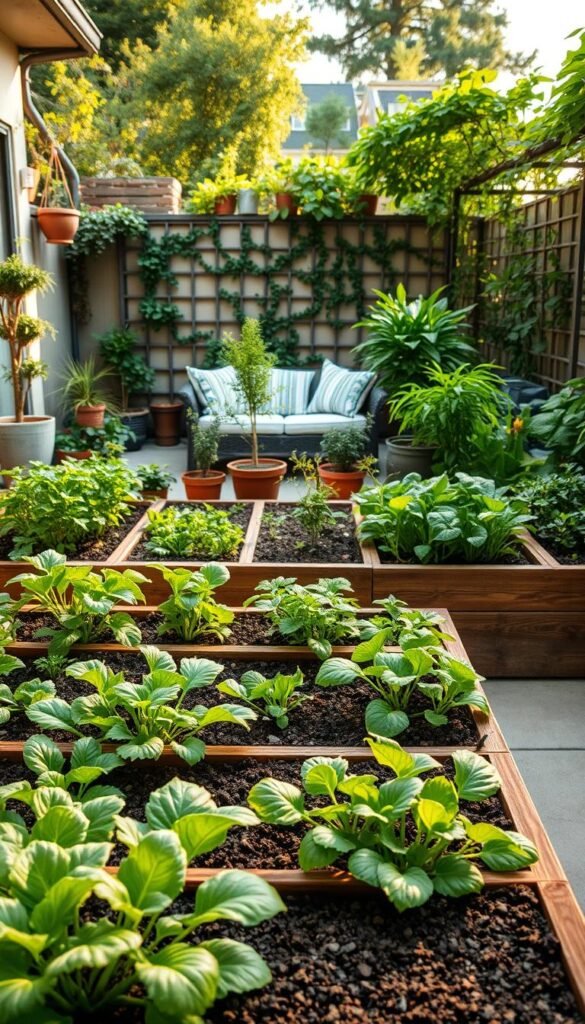
Imagine harvesting bushels of veggies from a space smaller than a parking spot. Real growers prove it’s possible through clever spatial planning. Let’s explore how everyday plant lovers maximize every inch with battle-tested strategies.
Innovative Layout Ideas from Real Gardeners
Square-foot gardening revolutionizes small plots. Denver resident Clara Nguyen grows 18 crops in 16 sq ft using this method. Her secret? Four 4×4 boxes with precise spacing:
| Crop | Plants per Square | Harvest Frequency |
|---|---|---|
| Radishes | 16 | 3 weeks |
| Spinach | 9 | Cut-and-come-again |
| Tomatoes | 1 | Weekly (summer) |
Urban gardener Raj Patel transformed his fire escape with stackable planters. “I grow pole beans vertically, herbs in hanging tins, and strawberries in gutter systems,” he shares. His 15 sq ft setup yields 25 lbs of produce annually.
Balcony growers often mix beauty with bounty. Try edible flowers like nasturtiums around lettuce beds, or train cherry tomatoes up decorative obelisks. As SFG inventor Mel Bartholomew advised: “Don’t grow rows—grow results.”
Maximizing Yield with Dense Planting and Succession Crops
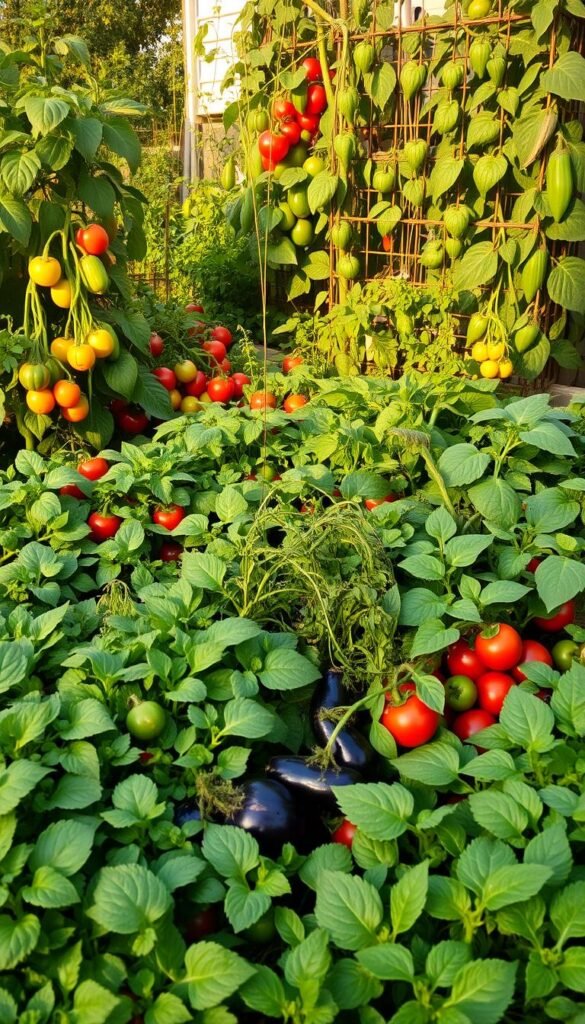
Your small growing area can produce more than you think when you challenge traditional spacing rules. Commercial seed recommendations often leave wasted space—home growers can pack plants closer while maintaining healthy growth. This approach turns every square inch into a food factory.
Strategies for Planting Densely
Ignore seed packet spacing guidelines meant for farm equipment. Most plants thrive when spaced 25-50% closer in containers or raised beds. Try the hand-scatter method:
- Broadcast seeds over prepared soil
- Gently rake to cover
- Thin crowded seedlings as they sprout
Thinning becomes a bonus harvest. Pull young beet greens for salads or snack on carrot sprouts. “I get two harvests from one planting,” notes urban gardener Tina Cho. “First microgreens, then mature veggies.”
Planning for Continuous Harvests
Keep your space productive all season with staggered planting. Start new crops every 2-3 weeks in these intervals:
- Fast growers: Lettuce (every 14 days)
- Medium cycle: Bush beans (every 21 days)
- Slow developers: Kale (every 30 days)
Create a simple calendar using sticky notes on your fridge. Mark planting dates for each crop, aligning with your local frost dates. For those with limited space, our guide on how to maximize your garden’s potential offers clever rotation strategies.
Small Garden Solutions with Containers and Window Boxes
Even the smallest corners can burst with homegrown flavor. Containers turn unused areas into edible hotspots—think stair edges, railings, or that sunny strip by your back door. A 20″ tub packed with kale, spinach, and marigolds proves you don’t need sprawling beds to grow fresh food.
Selecting the Right Containers
Material matters more than you think. Plastic pots keep soil moist, while terra cotta breathes better for herbs. Ensure drainage holes to prevent soggy roots. That vibrant mix of lettuce and violas? It’s thriving in a recycled bin with drilled holes and nutrient-rich soil.
Designing Attractive and Productive Window Boxes
Turn vertical surfaces into snack stations. Mount boxes on fences or windowsills for instant access to parsley or arugula. Pair edible greens with trailing nasturtiums—their peppery blooms spice up salads while deterring pests. Pro tip: Use cascading plants like thyme or basil to soften box edges.

